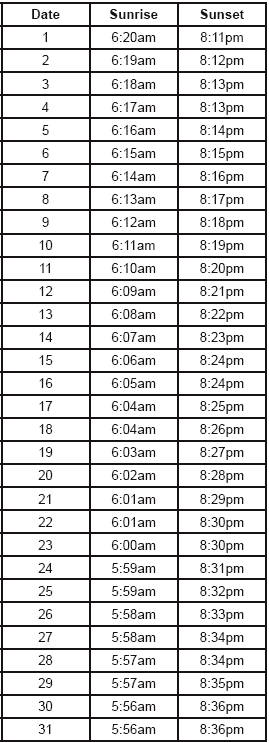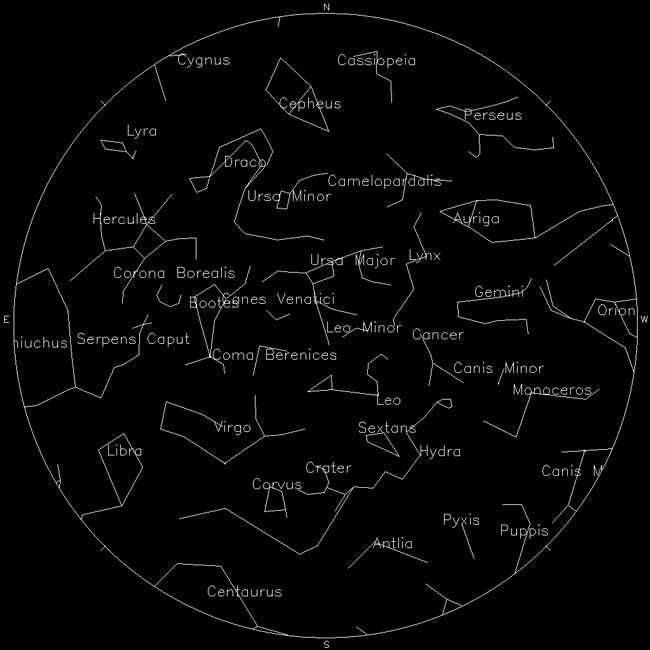Sunrise
and Sunset Times for
May 2008 |
 |
DAYLENGTH
Sunrise and sunset times may vary by one-half hour or more depending upon the terrain. The period of daylight lengthens by only 51 minutes during May compared to a 68-minute increase in the length of daylight last month. Since mid-February the angle of the sun in the sky (its declination) has rapidly been rising, which increases the duration of daylight. The change in declination occurs because the earth’s equator is tilted about 23.5 degrees from the plane of its orbit around the sun. In winter the sun shines more directly on the southern hemisphere, and in summer the northern hemisphere receives more direct sunlight. By mid-May the increase of the sun’s height in the sky begins to slow. Since the earth’s orbit is elliptical, its motion in space begins to parallel the apparent path of the sun across the sky (the ecliptic) as it approaches the far end of its orbit in June. As the northern hemisphere moves into the direct path of the sun, the effect of astronomical twilight is extended. By the end of the month its faint glow begins nearly two hours before sunrise. Nautical twilight, about one hour before sunrise, is marked by the appearance of color in the landscape. Civil twilight begins approximately one-half hour before sunrise when details in the landscape become clearly visible. The reverse progression applies to dusk.
MOON HAPPENINGS
April begins with a waning crescent moon in the southeastern sky at dawn. New Moon occurs on April 5. A waxing crescent reappears in the northwestern evening sky on April 7. On the evening of April 8 the moon occults (passes in front of) the Pleiades. On the night of April 11, a waxing crescent moves to within 0.5 degrees of Mars. On the evening of April 14 look directly overhead to see the gibbous moon in line with Saturn and Regulus in Leo. A nearly full moon passes below Virgo April 17-19. The Full Moon of April 20 can be seen twice. Look southwest as the moon becomes full in the early dawn skies of April 20. A nearly full moon rises again the same day in the eastern sky as twilight fades.
MOON HAPPENINGS
May begins with a waning crescent moon in the eastern sky at dawn. New Moon occurs May 5. On the evening of May 6 look two degrees below the thin crescent moon to locate Mercury on the northwestern horizon as twilight fades. On May 9 the waxing crescent moon appears in the evening sky between Mars and the twin stars Castor and Pollux in Gemini. Find the 1st quarter moon high overhead on the evening of May 11. On May 12 the waxing gibbous moon appears high in the sky between Saturn and Leo’s bright star Regulus. On May 16 Virgo’s bright star Spica sits just above the waxing gibbous moon. The Full Moon rises at 8:38pm on May 19 followed by a waning moon on May 20 rising with Antares in the heart of Scorpius. By May 23 the moon is rising after midnight with Jupiter. Look for the waning 3rd quarter moon in the early morning hours of May 28.
METEOR SHOWERS
Three meteor showers overlap during the first twelve days of May. A new moon on May 5 provides excellent viewing conditions for the peak period, and the waxing crescent moon that appears during the next few days sets soon after midnight. The best display is the Eta Aquarid Meteor Shower which can produce up to 25 brilliant meteor trails per hour. Best viewing will be the night of May 4 between 3:00am and 4:00am. Look eastward where Aquarius rises below Aquila. During the same period two minor meteor showers produce displays after midnight, one from the vicinity of Bootes and Hercules overhead and one to the south between Libra, Scorpius, and Ophiucus.
BEEHIVE CLUSTER
Look for this open star cluster near the bright star at the center of Cancer, halfway between Leo and Gemini. It looks like a faint nebulous cloud about 1.5 degrees in diameter to the northwest of the central star. With binoculars or a small telescope you can see individual stars. The Beehive Cluster contains about 200 stars that span about 16 light years across space.
Note: Hold your hand at arm’s length to measure apparent distances in the sky. The width of the little finger approximates 1.5 degrees. Middle, ring, and little finger touching represent about 5 degrees. The width of a fist is about 10 degrees. The hand stretched from thumb to little finger equals 20 degrees. The diameter of both the full moon and the sun spans only 0.5 degree.
VISIBLE PLANETS
Jupiter - brightest planet in the sky at magnitude -2.5; high overhead at dawn; rises soon after midnight by month’s end; moves eastward away from Sagittarius until May 9 when it begins retrograde movement and drifts westward back into Sagittarius over the next four months.
Mars -
midway in the western sky at dusk, dimming slightly to magnitude +1.4 by month’s end; moves eastward in the sky away from Gemini and towards the faint constellation Cancer; May 22-24 moves through the Beehive Cluster; look for it just west of the central star of Cancer.
Mercury - good time to view this elusive planet; in early May it outshines (at magnitude -0.7) Saturn, Mars, and the night’s brightest stars; from a high vantage point with a clear view of the northwestern horizon look for it about 70-80 minutes after sunset just as the last rays of color fade into astronomical twilight; on May 1 Mercury sits beneath the Pleiades; on May 6 look below the crescent moon; fades in brightness throughout the month but rises higher in the sky as it approaches its greatest elongation (distance from the sun as viewed from Earth) on May 13 and sets soon after 10:00pm; dims rapidly and disappears from view by the last week of May.
Saturn - high in the sky at dusk shining at magnitude +0.6, slightly brighter than 1st magnitude star Regulus to the west in Leo; ends its western retrograde movement on May 3 when it begins to drift eastward away from Regulus; last good opportunity to view its rings for several years.
Venus - too close to the sun to be visible as its orbit carries it behind the sun.
Note: Apparent magnitude values range from -4 to +5 for most planets and visible stars. The lower the value the brighter the object.
MAJOR
CONSTELLATIONS OF FEBRUARY |
Overhead
Bootes
Corona Borealis
Virgo
|
Northward
Cassiopeia
Cepheus
Ursa Major
Ursa Minor
|
Eastward
Aquila
Cygnus
Hercules
Lyra
Ophiucus |
Southward
Corvus
Crater
Hydra
|
Westward
Cancer
Gemini
Leo |
The four brightest stars of Libra form a small square in the southern sky. This star group was once
considered to be the claws of Scorpius,
now rising to the southeast of Libra.

Hold the star chart high above
your head and match the compass directions to the direction
you are facing.
Adjust the star chart by orienting Ursa Major (Big Dipper) to match its position
in the sky.
The star chart approximates the
night sky from astronomical twilight to midnight. As the night
and the month progress, the constellations will shift toward
the northwest. |
|

